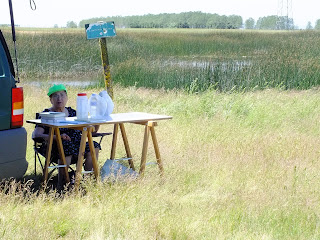My friend Kaire, one of the most important specialists in characeans in Estonia, asked me some time ago to help her in a Project to study the populations of Chara connivens through Europe. The objective of my help would be as simple as taking samples from our lakes and send her for a detailed genetic analysis.
Chara connivens is not very abundant in our región (Castilla-Leon) but has been commonly found in several shallow lakes and ponds in the León province, being the Velaza pond one of them.
C. connivens: female (left) and male (right) stands
C. connivens: figures e) to i).
From Cirujano et al. 2008. Flora Iberica. Aguas continentales. Carófitos. Real Jardín Botánico. Madrid
AREA OF STUDY
Several small ponds in the vicinity of the Villamuñio village (León, Spain) were surveyed. This area is of special conservation interest for flora and fauna due to the presence of several endangered species from temporary ponds. Isolated ponds work like small islands of populations only connected by birds transport (zoochoria).
MATERIAL & METHODS
1- Bibliography: This is the basic bibliograpy you need to determine characeans in Spain
the book on Characeae can be found in the web.
2- Field technician
3- High-tech materials
THE VELAZA POND
Small pond of 1.18 Ha
 |
| Potamogeton gramineus |
 |
| Callitriche sp. |
 |
| Antinoria agrostidea AND Eleocharis palustris |
Videos on the Velaza pond:
THE SURCO POND
Small pond (0.2 Ha), with 62 ugTP/L, 0.32 mgN-NO3/L. Covered by Chara globularis, Myriophyllum alterniflorum, Potamogeton trichoides.
THE ESTORRUBIO POND
Small pond of 0.83 Ha, and 1.5 m máximum depth. 281 ugTP/L, 0,57 mgN-NO3/L.
Vegetation: Chara globularis, Nitella spp., Eleochris palustris, Scirpus lacustris, Typha angustifolia.
THE MAYOR. TEMPORARY POND
A temporary pond of about 3.13 Ha, with 190 ugTP/L and 0.233 ugN-NO3/L, 3.6NTU turbidity.
Vegetation: Myriophyllum alterniflorum, Eleocharis palustris, Antinoria agrostidea, Mentha cervina, Alopecurus geniculatus, Iittorella uniflora, Isoetes velata.
Anostracea (probably Triops spp.) were very abundant many years ago.
THE VILLAMUÑIO POND
 |
| Briozoa on a plastic bottle in the El Terral (Villamuñio) pond |











No hay comentarios:
Publicar un comentario